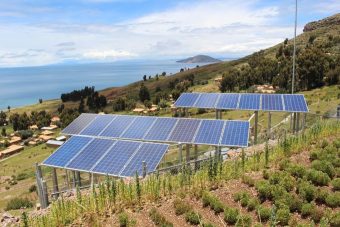
Numerous projects to build large solar power facilities are underway in Vietnam, as the country scrambles to make up for the anticipated power shortage due to the recent cancellation of nuclear power plant construction projects.
Thien Tan Group will by 2020 spend $2 billion to build five large solar power plants in the southern province of Ninh Thuan. A 50 megawatts solar plant will start operating this year, followed by four plants generating 200-300MW each. The five solar plants will generate an estimated 1 gigawatts, equivalent to the total power output of a nuclear reactor.
The Vietnamese government had planned to build two nuclear power plants with Russia and Japan in the province. Japanese nuclear power plant manufacturers and power companies aimed to win contracts, but the plan was cancelled in November 2016 due to the hefty up-front costs of several billion dollars per reactor.
Ninh Thuan Province — which is blessed with ample sunshine and abundant idle land — is highly suitable for solar power generation. The province is trying to attract solar power plants as an alternative to nuclear. The province plans to attract 4.85GW worth of large solar power plants by 2030.
TTC Group decided to tap into the solar power generation business. By 2020, the sugar, energy, real estate and tourism conglomerate will build 20 large solar power plants in southern provinces with ample sunshine, including a 320MW plant in Tay Ninh Province and a 300MW facility in Binh Thuan Province.
Power generation capacity will reach 1GW by 2020, when all large solar power plants start operating. Total investment amount is estimated at $1 billion, including wind power plants.
Khanh Hoa Province also invited solar power plants generating 120MW of electricity operated by Vietnam Electricity and others. These plants are forecast to start operating from this year.
Southern Vietnam, excluding Ho Chi Minh City, the country’s largest city, has a lot of idle land, and it is relatively easy to secure the 50-70 hectare sites required for large solar power plants. Annual energy production in southern Vietnam is expected to be 20-30% higher than that of Japan’s major cities, according to a local newspaper.
The government is trying to nurture solar power generation as the country’s main source of electrical power. Currently solar power only accounts for 0.01% of total power generation capacity, but the government plans to increase the ratio to 3.3% by 2030 and 20% by 2050.
As solar panel prices are declining and the government is expected to introduce a system of buying excess solar power, solar will likely rapidly spread to households in general.
Source: asia.nikkei.com



